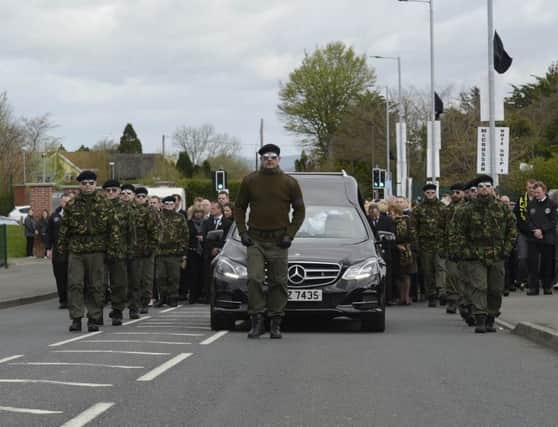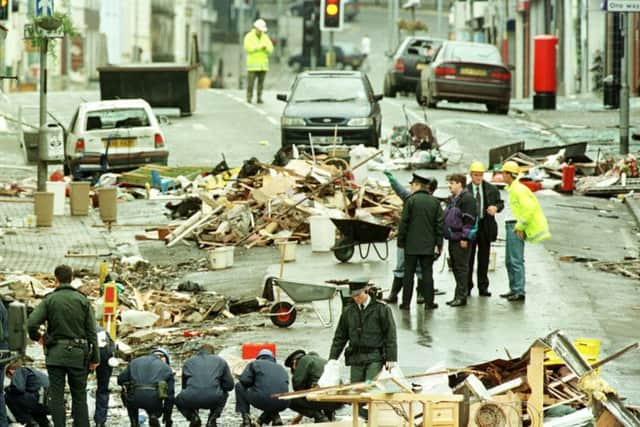Insight: Is long-dead IRA threat now back on the rise?


There was one message issued this Easter which focused not on resurrection, but death. It came from the New IRA, a forewarning as the centenary of the Easter Rising approached. In it, the republican terror group’s army council promised not only more attacks on prison officers and members of the security forces in Northern Ireland, but a strike at the very heart of Britain. “The volunteer soldiers of the IRA are ready and determined to take the war to the age old enemy of our nation,” it stated.
Although the vast operation to ensure those centenary commemorations were observed peacefully proved successful, it is now business as usual when it comes to assessing and thwarting potential attacks. The decision by MI5 to raise the threat level from Northern Ireland-related terrorism in Britain from “moderate” to “substantial” indicates that, while the danger posed by dissident republican groups has receded over the past two decades, it is now on the rise once again.
Advertisement
Hide AdAdvertisement
Hide AdFor the people of the province, the situation comes as no surprise. Figures released on Thursday, the day after Home Secretary Theresa May’s written statement to parliament, show that the Police Service of Northern Ireland (PSNI) recorded 52 bomb attacks in the past 12 months, a 44 per cent increase on the previous year.


But beyond the province, it is the prospect of an attack on Scottish, English or Welsh soil that is exercising minds. Nearly 15 years have passed since the detonator of a Real IRA car bomb exploded in Birmingham city centre. New terror threats, such as IS and al-Qaeda, may have emerged in that period, but last week’s announcement – the first time the threat has been “substantial” since the summer of 2011 – confirms that the old dangers very much remain.
Determining how grave they are requires a careful of analysis of May’s 113-word statement.
The key phrase in her submission specified the “strong possibility” of a terrorist attack which “reflects the continuing threat from dissident republican activity”. The subtext is important. Although May did not name any one group, it is the New IRA that is at the forefront of her thoughts.
The group has only been formally recognised for four years, but its ranks – mainly drawn from north and west Belfast, Lurgan in Co Armagh and parts of Co Londonderry – include a host of older organisations such as the Real IRA, Oglaigh na hEireann and Republican Action Against Drugs.


Financed through criminality such as fuel laundering and cigarette smuggling, it commands little community support, yet retains a tight grip in certain areas through fear and the threat of reprisals.
The numbers involved are unclear, but the fact the group has been linked to a series of murders and bomb attacks would suggest they are sufficient to make a brutal impact. Less than a fortnight ago, it made its presence felt at the funeral of dissident Mickey Barr, with two lines of men in paramilitary-style clothing flanking his coffin.
For longstanding observers of Northern Ireland’s fractious peace, the decision by MI5 to raise the threat level shows that the cause of dissident republicanism can still rely on supporters.
Advertisement
Hide AdAdvertisement
Hide AdAccording to Jonathan Tonge, professor of politics at the University of Liverpool, the movement came as close as it could to extinction after the Omagh bombing in 1998 when a “widespread wave of revulsion” left it incapable of gaining any traction whatsoever.
But since 2007, it has found a new audience. Tonge, who has studied the evolution of dissident republicanism since the Good Friday Agreement, attributes that trend to the landmark decision by Sinn Fein members to support policing in Northern Ireland for the first time in the party’s history.
Disaffected old guard Provisionals stuck with Sinn Fein after the Provisional IRA retreated in 2005, Tonge says. But two years later, they suddenly found themselves facing a “difficult decision”.
“I actually think Sinn Fein’s decision to support the police was more important in terms of dissident growth than the Good Friday Agreement, which had massive support amongst nationalists,” he explains. “The police issue was difficult for republican militants and today, they don’t see any movement towards a united Ireland.”
In addition to those who lived – and fought – through The Troubles, Tonge says there is a “new generation” of dissidents with a disregard for modern history. “They see the Good Friday Agreement as old news and don’t see any significant peace in their communities,” he says.
“Put those two together and you’ve probably got enough recruits to keep going in some capacity for the foreseeable future. It’s a problem that can probably be contained, but not eradicated.”
Others believe the political situation has given the dissidents reason to renew their fight. Dr Paul Breen, senior lecturer at the University of Westminster and a contributor to The Conversation, points to the failure of Sinn Fein and the SDLP to offer much in the way of a “realistic approach to unification”.
He says: “This has possibly also acted as a spark for the dissidents, whose vision has always been clear and brutal. They want an end to British government involvement in Ireland, and the right of self-determination for their people. They do not believe Sinn Fein’s strategy is working and are prepared to resort to violence to achieve reunification.”
Advertisement
Hide AdAdvertisement
Hide AdIf the intent of the New IRA has never been in doubt, last week’s heightened threat level may well offer a sign that both its capacity and capability have grown. The warning signs have been flagged up by the PSNI over the past year, with the force noting that dissidents have used homemade bombs and improvised rocket launchers as well as guns. Some of the devices, such as magnetic explosives which attach the underside of vehicles, bear hallmarks of strategies and engineering techniques employed by the Provisional IRA in the 1980s.
Security sources have suggested the group has access to a sizeable hoard of Semtex, probably once part of old IRA stock procured from Libya. If that is the case, it would justify long-term concerns that the decommissioning process – a defining issue of the Good Friday Agreement – was only a qualified success.
It has been estimated that, at the turn of the century, the IRA’s various factions held around 1,000 rifles, most of which were AK-47s, and as much as two tonnes of Semtex, not to mention heavy weaponry.
The process by which that was to have been “put beyond use” was, Tonge says, a “symbolic, confidence building aspect” of the peace process. He, like many observers, has doubts over its efficacy.
“There were only two independent witnesses to the decommissioning that took place, a member of the Catholic clergy and a member of the Protestant clergy,” he says. “We’ve no idea whether all the weaponry was decommissioned.
“Instinctively, you’d think it probably wasn’t – some guns would be kept in reserve, and it’s almost inconceivable that all the weapons would have been decommissioned, because they were so scattered across the country. It would have made the process very difficult logistically.”
If the perfect storm has come to pass and the New IRA has both the desire and means to strengthen its offensives on the British mainland, the efforts of MI5 and police forces will be focused in England and Wales. Though the existing threat relates to Great Britain as a whole, it is worth remembering that historically, Scotland has rarely been in the sights of republic terror groups.
Despite a string of bomb attacks at three pubs in Glasgow by Scottish members of the Ulster Volunteer Force in the 1970s, tensions never spilled over into the kind of bloody conflict that has played out in Northern Ireland.
Advertisement
Hide AdAdvertisement
Hide AdIndeed, there has only ever been one recorded republican terror attack in Scotland when, in 1981, the IRA targeted the Queen as she inaugurated the Sullom Voe oil terminal. A bomb exploded at precisely the time she would have been making her speech, had her programme not been running late. There was little structural damage and no casualties. The incident was not made public.
While England is seen as a symbolically and militarily significant target, one Police Scotland source said there was no room for complacency in the light of the escalated threat level, with the force focusing on a minority who might help facilitate and provide logistical support for attacks.
“The important link is between organised crime and terrorism,” the source explained. “Guns are seen as a commodity and there is a threat that they can fall into the wrong hands as a result, so it’s constantly being monitored.”
The force has already enjoyed success with Operation Hairsplitter, launched to investigate an attempt to procure firearms by a gang led by Anton Duffy, the ringleader of what Police Scotland described as an “unaffiliated active service unit” who was inspired by dissident republicanism. He and two other men were convicted last year in the High Court in Glasgow of planning to murder two former leaders of the Ulster Defence Association.
“The intention of the plot was to start a war. It was a major multi-agency intelligence and surveillance operation” the police source recalls. “That’s very much the focus. At the same time there is an understanding that the threat from international terrorism remains higher than Northern Ireland-related terrorism.”
It is a distinction May herself made last week. The prospect of an attack co-ordinated by dissident republicans is classified as a “strong possibility”. Only when the threat level reaches severe would it become “highly likely”.
Yet, she added, the “stated aims” of those who wage violent dissident republican activity meant it would be “sensible” for the public to “remain vigilant”.
It is a predictable call, but other observers believe raising the threat level could well be a pre-emptive psychological ploy on the part of the British security services.
Advertisement
Hide AdAdvertisement
Hide AdBrian Rowan, the veteran Northern Irish security correspondent, stressed last week that in terms of gaining intelligence on prospective attacks, “the jigsaw has missing pieces… the picture is never complete”.
Part of the heightened threat alert, he believes, is a “mind game”. He explains: “When you put out a statement like that, it makes the dissidents think about what’s known, what’s been heard, who’s been talking, and the effect of all of that can be to interrupt and maybe even to stop plans.”
Tonge is inclined to agree with such a view. “It’s important to stress that the threat level has only gone up to substantial,” he says. “That only means there’s a strong possibility of an attack, which is quite different from it being a probability. We’re never privy to what the intelligence services know, but I suspect it’s an exercise to cover their backs more than anything else.”
The authorities and the British public will hope that proves to be the case, but 18 years after the signing of the Good Friday Agreement, a threat many thought had receded into obsolescence remains.